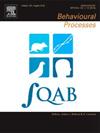Life history stage effects on alert and flight initiation distances in king penguins (Aptenodytes patagonicus)
IF 1.3
4区 生物学
Q4 BEHAVIORAL SCIENCES
引用次数: 0
Abstract
When approached by predators, prey must decide whether to flee or remain and fight. The economics of such decisions are underlain by the trade-off between current and residual fitness. The trade-off predicts that (i) breeders should be less prone than non-breeders to flee from approaching predators, as breeders can lose their investment into current reproduction; (ii) among breeders, parents should increasingly defend their offspring with increasing investment into the brood (brood value hypothesis), at least until the offspring can independently take part in anti-predator defenses; and (iii) for a similar investment into reproduction, breeders with lower perspectives to fledge or wean their young should invest less into offspring defense. We tested these predictions in a colonially breeding seabird, the king penguin (Aptenodytes patagonicus). Specifically, we considered how antipredator behaviors varied according to life history stage (molting, courting, breeding), offspring age and their dependence on parents for antipredator defenses, and the timing of breeding, with late breeders being very unlikely to fledge offspring in this species. Using non-lethal human approaches to mimic the threat of predation, we approached > 500 penguins and measured their alert and flight initiation distances, as well as the distance fled. We found that birds showed increasingly stronger antipredator behaviors as they initiated and increased their investment into reproduction, from non-reproductive stages to courting and brooding small, thermo-dependent chicks. However, once offspring gained thermal independence and freedom of movement, parents reduced their antipredator behaviors. Late breeders were more likely to flee from the approaching threat than early breeders. Altogether, our results demonstrate that parental antipredator responses are dynamic and shaped by the levels of investment into current reproduction, the ability of offspring to defend themselves, and the perceived future value of the brood.
帝企鹅(Aptenodytes patagonicus)生活史阶段对警觉和飞行起始距离的影响。
当掠食者靠近时,猎物必须决定是逃跑还是留下来战斗。这类决策的经济学依据是当前适应度与剩余适应度之间的权衡。这种权衡预示着(1)繁殖者应该比非繁殖者更不容易逃离接近的捕食者,因为繁殖者可能会失去对当前繁殖的投资;(ii)在繁殖者中,父母应该越来越多地保护自己的后代,增加对后代的投入(后代价值假设),至少直到后代能够独立参与反捕食者防御;(iii)对于繁殖的类似投资,对幼崽羽化或断奶的期望较低的繁殖者应该减少对后代保护的投资。我们在一种群集繁殖的海鸟——帝企鹅(Aptenodytes patagonicus)身上测试了这些预测。具体来说,我们考虑了反捕食者行为是如何根据生活史阶段(换毛、求偶、繁殖)、后代年龄及其对父母的依赖来防御捕食者的,以及繁殖的时间而变化的,在这个物种中,晚繁殖者不太可能羽化后代。我们使用非致命的人类方法来模拟捕食者的威胁,接近了bb500只企鹅,并测量了它们的警觉和飞行起始距离,以及逃离的距离。我们发现,随着鸟类开始并增加对繁殖的投资,从非繁殖阶段到求爱和孵小的、依赖温度的雏鸟,它们表现出越来越强的反捕食者行为。然而,一旦后代获得了热独立性和行动自由,父母就会减少它们的反捕食行为。晚育种者比早育种者更有可能逃离即将到来的威胁。总之,我们的研究结果表明,父母的反捕食者反应是动态的,并由当前繁殖的投资水平、后代保护自己的能力以及对后代未来价值的感知所决定。
本文章由计算机程序翻译,如有差异,请以英文原文为准。
求助全文
约1分钟内获得全文
求助全文
来源期刊

Behavioural Processes
生物-动物学
CiteScore
2.70
自引率
7.70%
发文量
144
审稿时长
4-8 weeks
期刊介绍:
Behavioural Processes is dedicated to the publication of high-quality original research on animal behaviour from any theoretical perspective. It welcomes contributions that consider animal behaviour from behavioural analytic, cognitive, ethological, ecological and evolutionary points of view. This list is not intended to be exhaustive, and papers that integrate theory and methodology across disciplines are particularly welcome.
 求助内容:
求助内容: 应助结果提醒方式:
应助结果提醒方式:


